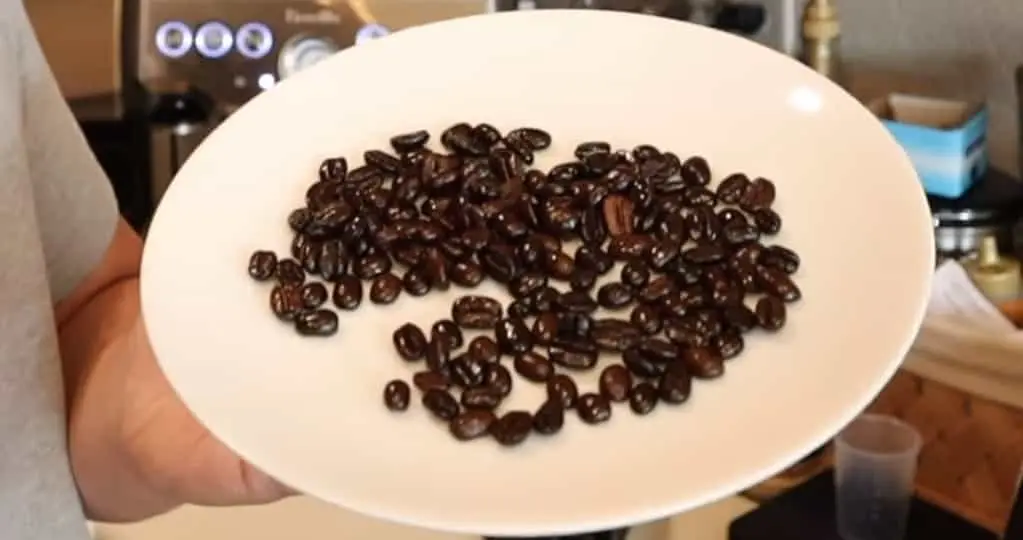If you’re a coffee lover, you may have noticed that some coffee beans have a shiny, oily sheen on the surface. While this might look appealing, oily coffee beans can actually impact the taste and aroma of your coffee. Oily beans tend to be darker and more bitter, which can overwhelm the natural flavors of the coffee and leave an unpleasant aftertaste.
To avoid this, it’s important to properly dry your coffee beans before roasting and brewing. Drying the beans helps to remove excess moisture, which can cause the beans to become oily. It also helps to ensure that the coffee beans roast more evenly, resulting in a better brew.
In this article, we’ll discuss the science behind drying oily coffee beans, different techniques for drying, and step-by-step instructions for each method. We’ll also cover the importance of storing dried coffee beans properly to maintain their quality. By the end of this comprehensive guide, you’ll have all the knowledge you need to effectively dry your coffee beans for a better brew. So let’s get started!
Understanding the Science of Drying Oily Coffee Beans
To understand why oily coffee beans need to be dried, it’s important to first understand the chemical process that makes them oily. Coffee beans contain natural oils that are released during roasting. These oils give the beans their characteristic aroma and flavor, but they can also cause the beans to become oily on the surface.
When coffee beans are roasted, the heat causes the oils inside the beans to migrate to the surface. If the beans are roasted for too long or at too high a temperature, the oils can accumulate on the surface, making the beans shiny and oily. This can negatively affect the flavor of the coffee by making it bitter and less nuanced.
In addition to roasting, storage conditions can also impact the moisture content of coffee beans. Exposure to air and moisture can cause coffee beans to absorb moisture, which can contribute to the development of oily beans.
To combat the development of oily coffee beans, it’s important to dry them properly. Drying coffee beans helps to remove excess moisture, which can help prevent the oils from accumulating on the surface. It also helps to ensure that the beans roast more evenly, resulting in a better brew.
The key to effective drying is to balance humidity and airflow. High humidity can slow down the drying process, while low humidity can cause the beans to dry too quickly, resulting in uneven roasting. Proper airflow helps to remove moisture from the beans while preventing them from becoming too dry too quickly.
This will help you achieve a better-tasting cup of coffee that highlights the natural flavors of the beans without the negative impact of oily surfaces.
Techniques for Drying Oily Coffee Beans
There are several different techniques for drying oily coffee beans, each with its own advantages and disadvantages. Here are some of the most popular methods:

Sun-drying: Sun-drying is a traditional method of drying coffee beans that involves spreading the beans out on a flat surface in the sun. This method is low-cost and effective in areas with high humidity and plenty of sunshine. However, it can be difficult to control the drying conditions, and the beans are exposed to potential contaminants such as dirt, insects, and bird droppings.
Mechanical drying: Mechanical drying involves using machines to dry the coffee beans quickly and efficiently. This method is commonly used in large-scale coffee production facilities, where time and efficiency are important. However, it can be expensive to purchase and maintain the equipment, and the high heat of the machines can potentially damage the flavor of the beans.
Air-drying: Air-drying involves using fans to circulate air around the beans, helping to remove moisture and dry them evenly. This method is popular among specialty coffee roasters, as it allows for more control over the drying conditions and can result in higher quality beans. However, it can be time-consuming and requires careful monitoring to ensure that the beans are drying at the proper rate.
Drum-roasting: Drum-roasting involves roasting the beans immediately after drying them in a rotating drum. This method is effective at removing excess moisture from the beans and can result in a more even roast. However, it requires specialized equipment and can be difficult to control the roast profile of the beans.
Regardless of the method you choose, it’s important to monitor the drying process carefully to ensure that the beans are drying at the proper rate and not becoming too dry or too moist. Properly dried coffee beans will result in a better-tasting cup of coffee that highlights the natural flavors of the beans.
Step-by-Step Guide to Drying Oily Coffee Beans
If you’re looking to dry oily coffee beans at home, here’s a step-by-step guide to get you started:
- Start with high-quality coffee beans: The quality of the beans you use will impact the flavor of your final cup of coffee. Choose fresh, high-quality beans that are free from defects.
- Rinse the beans: Rinse the beans with clean water to remove any dirt or debris.
- Spread the beans out: Spread the beans out on a flat surface, such as a tray or a screen, in a thin layer. This will help to ensure that the beans dry evenly.
- Choose a drying method: Choose a drying method that works best for your setup. Sun-drying is a low-cost option that works well in areas with plenty of sunshine, while air-drying or drum-roasting may be better for more controlled environments.
- Monitor the beans: Monitor the beans carefully as they dry to ensure that they are drying at the proper rate. The beans should feel slightly tacky to the touch but should not be wet.
- Store the beans: Once the beans are dry, store them in a cool, dry place in an airtight container. This will help to preserve the flavor of the beans until you’re ready to roast and brew them.
By following these steps, you can effectively dry oily coffee beans at home and achieve a better-tasting cup of coffee. Remember to choose high-quality beans, monitor the drying process carefully, and store the beans properly to ensure that they retain their flavor and aroma.
Storing Dried Oily Coffee Beans
Proper storage of dried oily coffee beans is key to preserving their flavor and aroma. Here are some tips for storing your beans:
Use an airtight container: Store your dried coffee beans in an airtight container, such as a glass jar or a sealed bag. This will help to prevent exposure to moisture, which can cause the beans to spoil.
Keep the beans in a cool, dry place: Store your coffee beans in a cool, dry place, away from direct sunlight and heat sources. Avoid storing them in the refrigerator or freezer, as the moisture and odors can affect the flavor of the beans.
Don’t grind the beans until you’re ready to brew: Grinding coffee beans exposes them to air, which can cause them to lose flavor and aroma. Wait until you’re ready to brew your coffee before grinding the beans.
Use the beans within two weeks of roasting: For the freshest-tasting coffee, use your dried oily coffee beans within two weeks of roasting. After that, the flavor and aroma may begin to degrade.
Use an airtight container, store them in a cool, dry place, and avoid grinding the beans until you’re ready to brew. With these tips, you can enjoy a better-tasting cup of coffee every time.
Frequently Asked Questions
How do you make coffee beans less greasy?
To make coffee beans less greasy, you can try roasting them for a longer time or at a higher temperature. You can also try washing the beans in water before roasting.
Will oily coffee beans clog grinder?
Yes, oily coffee beans can potentially clog a grinder. It’s important to clean your grinder regularly and adjust the grind setting as needed to prevent clogs.
How do you dry wet coffee beans?
To dry wet coffee beans, you can spread them out in a thin layer on a clean, dry surface and let them air dry or use a fan to speed up the drying process. It’s important to ensure that the beans dry thoroughly and evenly to prevent mold or spoilage.
Can I use oily coffee beans?
Yes, you can use oily coffee beans for brewing coffee. However, you may need to adjust your grinder settings and clean your equipment more frequently to prevent clogs and ensure a consistent grind.
Why are my coffee beans so oily?
Coffee beans can become oily due to factors such as the roasting process, the type of bean, and the level of freshness. Darker roasts and certain types of beans tend to be more oily than lighter roasts and other types of beans.
Should whole coffee beans be oily or dry?
Whole coffee beans can be either oily or dry, depending on factors such as the roast level and the type of bean. Oily beans can potentially clog grinders, but they can also offer a richer flavor and aroma.
What grind setting for oily beans?
For oily beans, you may need to adjust your grinder setting to a slightly coarser grind to prevent clogs and ensure a consistent grind size.
How do I clean the oil out of my coffee grinder?
To clean the oil out of your coffee grinder, you can use a cleaning tablet, grind rice or bread through the grinder, or use a brush to remove any excess oil and residue.
Can I use oily beans in burr grinder?
Yes, you can use oily beans in a burr grinder. However, you may need to adjust the grind setting and clean your grinder more frequently to prevent clogs and ensure a consistent grind.
Can I dry coffee beans in the oven?
It’s not recommended to dry coffee beans in the oven, as the heat can potentially damage the beans and affect their flavor. It’s best to use natural air-drying or a dehydrator to dry coffee beans.
Conclusion
Drying oily coffee beans is an important step in the coffee-making process that can greatly impact the flavor and aroma of your final cup of coffee. By understanding the science behind drying oily coffee beans, you can choose the best drying method and ensure that your beans dry evenly and thoroughly.
Whether you choose sun-drying, air-drying, or drum-roasting, be sure to monitor your beans carefully and store them properly to preserve their flavor and aroma. With the right techniques and equipment, you can achieve a better-tasting cup of coffee and enjoy the full potential of your favorite beans.
By following the step-by-step guide and tips outlined in this article, you can effectively dry oily coffee beans at home and take your coffee-making skills to the next level. So why not give it a try and see how a little extra effort can go a long way in improving the flavor and aroma of your daily cup of coffee.
A. I. Moon
A.I. Moon, an experienced SEO Pythonista, spends his days coding and developing web applications to help business owners. A passionate coffee enthusiast, he believes that drinking coffee fuels his creativity and productivity. His day isn't complete without the rich aroma and invigorating warmth of a perfectly brewed cup. This love for coffee inspired him to found EspressoRivo, a platform dedicated to sharing his coffee knowledge and fostering a community of passionate aficionados.






